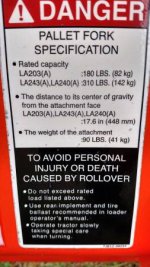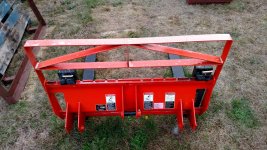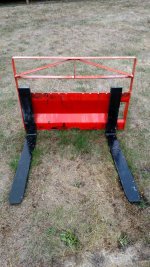For a BX: Kubota QA weighs around 50 pounds. The sticker Bruce posted indicates the attachment weighs 90 pounds. If you remove the bucket, you shed 130 pounds. Therefore, the QA and Kubota forks (I'm assuming that's where the sticker came from) weigh ten pounds more than the bucket, but also hold it out further. If I recall correctly, the QA pushed the bucket/forks out around six inches. This will decrease the lifting capacity, by increasing the swing distance (not utilizing the leverage as efficiently). The BX is rated to around 745 pounds, at the pins, to full height. Take away the bucket and you get a little over 600 pounds lift capacity, at the pins; whether it be the bucket or forks, without the QA. With the QA, we aren't going to get quite as much. Here's where I think it makes the difference, in the bucket, the furthest the load can be from the pins is 16 inches, or so (I didn't go measure), plus the QA. This keeps the weight of the load close or over the pins, if the bucket is curled back. With the forks, anything lifted will have to have the load pushed against the cage, to use the proper leverage. Of course, this isn't always an option. Generally, pallets are loaded with the heaviest part n the center, to distribute the load. This means the heaviest part of the load will be over two feet from the pins, plus the QA (if applicable). You cannot curl forks back, as far as you can a load of rock, in the bucket, to bring the center of gravity over the pins. With the EA setup, the SS QA is around 18 pounds heavier than the Kubota QA, but appears to pull the load in closer to the pins. That might make the extra weight a wash. It's a math problem and I refuse to try to figure it up, with curved loader arms and all the variables. The EA forks/cage setup weighs significantly more than the Kubota (if this sticker is from the forks/cage setup). 238 versus 90 is a huge difference. Either the EA is built a lot heavier than the Kubota setup or we aren't getting the entire picture of the Kubota setup. I am thinking, by the numbers, this weight is just for the Kubota forks; perhaps, clamp on forks, or the like. If you take the 238 for the EA forks and the 68 for the EA SS QA, you get 306 pounds. Take that from the 745 and you get 439 pounds, left, at the pins. That number will diminish as the CoG moves further forward. If the Kubota setup is forks and cage, at 90 pounds, plus the 50 pound QA, that would leave 605 pounds of rated lifting capacity, to full height, at the pins. It would also mean the Kubota forks and cage were VERY light duty. For comparison, the Northern Tool clamp on 1K rated forks weigh in at 74 pounds. I believe that's for both.



